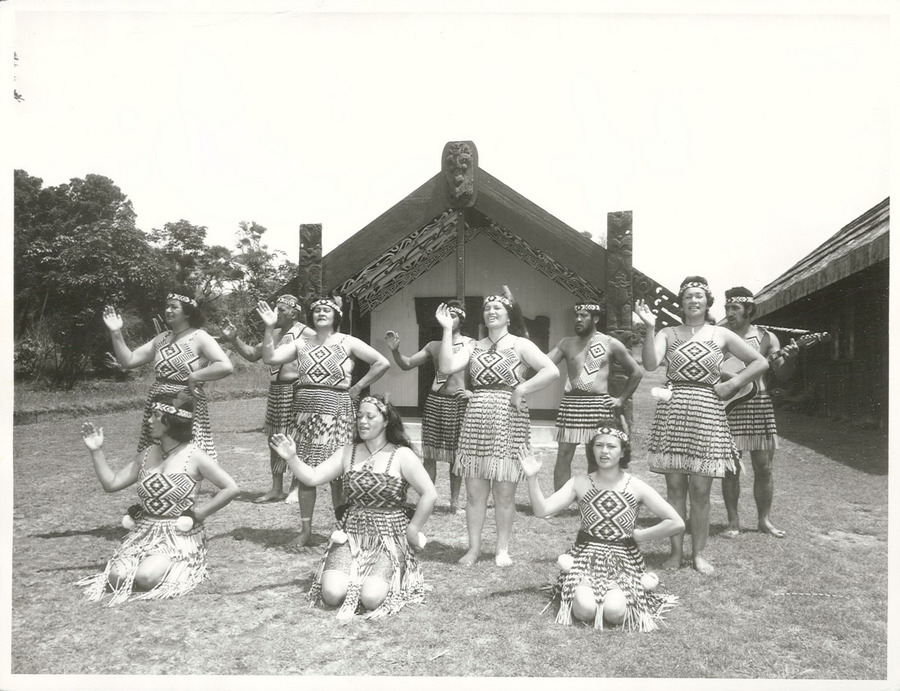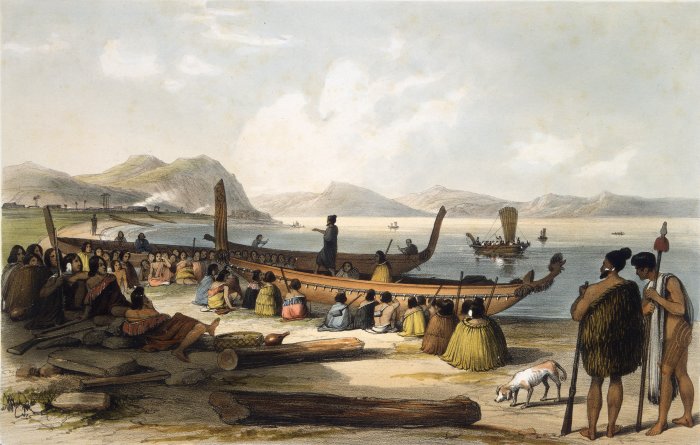|
Kapa Haka
Kapa haka is the term for Māori action songs and the groups who perform them. It literally means 'group' () and 'dance' (). Kapa haka is an important avenue for Māori people to express and showcase their heritage and cultural Polynesian identity through song and dance. Modern kapa haka traces back to pre-European times where it developed from traditional forms of Māori performing art; haka, (weaponry), (ball attached to rope or string) and (traditional Māori songs). There is a regular national kapa haka competition currently called Te Matatini that has been running since 1972. A kapa haka performance involves choral singing, dance and movements associated with the hand-to-hand combat practised by Māori in mainly precolonial times, presented in a synchronisation of action, timing, posture, footwork and sound. The genre evolved out of a combination of European and Māori musical principles. The current form relates to kapa haka concert groups that first appeared in the ... [...More Info...] [...Related Items...] OR: [Wikipedia] [Google] [Baidu] |
Body Percussion
Body percussion may be performed on its own or as an accompaniment to music and/or dance. Examples of countries' folk traditions that incorporate body percussion include Indonesian saman, Ethiopian armpit music, palmas in flamenco, and the hambone from the United States. Body percussion is a subset of "body music". Body percussion sounds Percussion instruments produce their sound when a player hits, scrapes, rubs or shakes them to produce vibrations. These techniques can also be applied to the human body. The body also presents several unique possibilities including the use of inhaled or exhaled air and vocal sounds. Traditionally the four main body percussion sounds (in order from lowest pitch to highest in pitch) are: #Stomping: Striking left, right, or both feet against the floor or other resonant surface #Patting: Patting either the left, right, or both thighs or cheeks with hands # Clapping hands together # Snapping fingers However, there are numerous other possibilities ... [...More Info...] [...Related Items...] OR: [Wikipedia] [Google] [Baidu] |
Māori Words And Phrases
Māori or Maori can refer to: Relating to the Māori people * Māori people of New Zealand, or members of that group * Māori language, the language of the Māori people of New Zealand * Māori culture * Cook Islanders, the Māori people of the Cook Islands * Cook Islands Māori, the language of the Cook Islanders Ships * SS ''Maori'', a steamship of the Shaw Savill Line, shipwrecked 1909 * , a Royal Navy Tribal-class destroyer, sunk in 1915 * , a Royal Navy Tribal-class destroyer, launched 1936 and sunk 1942 * TEV ''Maori III'', a Union Steam Ship Company inter-island ferry, 1952–74 Sports teams * New Zealand Māori cricket team * New Zealand Māori rugby league team * New Zealand Māori rugby union team Other * ''Maori'', a novel by Alan Dean Foster *Mayotte, in the Bushi language Bushi or Kibosy (''Shibushi'' or ''Kibushi'') is a dialect of Malagasy spoken in the Indian Ocean island of Mayotte. Malagasy dialects most closely related to Bushi are spoken in northwe ... [...More Info...] [...Related Items...] OR: [Wikipedia] [Google] [Baidu] |
New Zealand Styles Of Music
New is an adjective referring to something recently made, discovered, or created. New or NEW may refer to: Music * New, singer of K-pop group The Boyz Albums and EPs * ''New'' (album), by Paul McCartney, 2013 * ''New'' (EP), by Regurgitator, 1995 Songs * "New" (Daya song), 2017 * "New" (Paul McCartney song), 2013 * "New" (No Doubt song), 1999 *"new", by Loona from '' Yves'', 2017 *"The New", by Interpol from ''Turn On the Bright Lights'', 2002 Acronyms * Net economic welfare, a proposed macroeconomic indicator * Net explosive weight, also known as net explosive quantity * Network of enlightened Women, a conservative university women's organization * Next Entertainment World, a South Korean film distribution company Identification codes * Nepal Bhasa language ISO 639 language code * New Century Financial Corporation (NYSE stock abbreviation) * Northeast Wrestling, a professional wrestling promotion in the northeastern United States Transport * New Orleans Lakefront Airp ... [...More Info...] [...Related Items...] OR: [Wikipedia] [Google] [Baidu] |
Plastic Shopping Bag
Plastic shopping bags, carrier bags, or plastic grocery bags are a type of plastic bag used as shopping bags and made from various kinds of plastic. In use by consumers worldwide since the 1960s, these bags are sometimes called single-use bags, referring to carrying items from a store to a home. However, it is rare for bags to be worn out after single use and in the past some retailers (like Tesco and Sainsbury's in the UK) incentivised customers to reuse 'single use' bags by offering loyalty points to those doing so. Even after they are no longer used for shopping reuse for storage or trash is common, and modern plastic shopping bags are increasingly recyclable or compostable. In recent decades, numerous countries have introduced legislation restricting the sale of plastic bags, in a bid to reduce littering and plastic pollution. Some reusable shopping bags are made of plastic film, fibers, or fabric. History American and European patent applications relating to the produc ... [...More Info...] [...Related Items...] OR: [Wikipedia] [Google] [Baidu] |
Flax
Flax, also known as common flax or linseed, is a flowering plant, ''Linum usitatissimum'', in the family Linaceae. It is cultivated as a food and fiber crop in regions of the world with temperate climates. Textiles made from flax are known in Western countries as linen and are traditionally used for bed sheets, underclothes, and table linen. Its oil is known as linseed oil. In addition to referring to the plant, the word "flax" may refer to the unspun fibers of the flax plant. The plant species is known only as a cultivated plant and appears to have been domesticated just once from the wild species '' Linum bienne'', called pale flax. The plants called "flax" in New Zealand are, by contrast, members of the genus '' Phormium''. Description Several other species in the genus ''Linum'' are similar in appearance to ''L. usitatissimum'', cultivated flax, including some that have similar blue flowers, and others with white, yellow, or red flowers. Some of these are perennial ... [...More Info...] [...Related Items...] OR: [Wikipedia] [Google] [Baidu] |
Typha Orientalis
''Typha orientalis'', commonly known as bulrush, cumbungi, or raupō, is a perennial herbaceous plant in the genus ''Typha''. It is native to Australia, New Zealand, Malaysia, Indonesia, Japan, Korea, Mongolia, Myanmar, Philippines, China and the Russian Far East (Sakhalin and Primorye). ''T. orientalis'' is a wetland plant that grows on the edges of ponds, lakes, salt marshes, and slow flowing rivers and streams. Use Known as raupō in New Zealand, the plant was quite useful to Māori. The rhizomes were cooked and eaten, while the flowers were baked into cakes. The leaves were used for roofs and walls and occasionally for canoe sails, as well as a material for making kites. Māori introduced the plant to the Chatham Islands The Chatham Islands ( ) ( Moriori: ''Rēkohu'', 'Misty Sun'; mi, Wharekauri) are an archipelago in the Pacific Ocean about east of New Zealand's South Island. They are administered as part of New Zealand. The archipelago consists of about t .... ... [...More Info...] [...Related Items...] OR: [Wikipedia] [Google] [Baidu] |
Coxswain
The coxswain ( , or ) is the person in charge of a boat, particularly its navigation and steering. The etymology of the word gives a literal meaning of "boat servant" since it comes from ''cock'', referring to the cockboat, a type of ship's boat, and ''swain'', an Old English term derived from the Old Norse ''sveinn'' meaning boy or servant. In 1724, a "cockswain" was defined as "An officer of a ship who takes care of the cockboat, barge or shallop, with all its furniture, and is in readiness with his crew to man the boat on all occasions." When the term "cockboat" became obsolete, the title of coxswain as the person in charge of a ship's boat remained. Rowing In rowing, the coxswain sits in either the bow or the stern of the boat (depending on the type of boat) while verbally and physically controlling the boat's steering, speed, timing and fluidity. The primary duty of a coxswain is to ensure the safety of those in the boat. In a race setting, the coxswain is tasked with ... [...More Info...] [...Related Items...] OR: [Wikipedia] [Google] [Baidu] |
Waka (canoe)
Waka () are Māori watercraft, usually canoes ranging in size from small, unornamented canoes (''waka tīwai'') used for fishing and river travel to large, decorated war canoes (''waka taua'') up to long. The earliest remains of a canoe in New Zealand were found near the Anaweka estuary in a remote part of the Tasman District and radiocarbon-dated to about 1400. The canoe was constructed in New Zealand, but was a sophisticated canoe, compatible with the style of other Polynesian voyaging canoes at that time. Since the 1970s about eight large double-hulled canoes of about 20 metres have been constructed for oceanic voyaging to other parts of the Pacific. They are made of a blend of modern and traditional materials, incorporating features from ancient Melanesia, as well as Polynesia. Waka taua (war canoes) ''Waka taua'' (in Māori, ''waka'' means "canoe" and '' taua'' means "army" or "war party") are large canoes manned by up to 80 paddlers and are up to in length. Large w ... [...More Info...] [...Related Items...] OR: [Wikipedia] [Google] [Baidu] |
Haka
Haka (; plural ''haka'', in both Māori and English) are a variety of ceremonial performance art in Māori culture. It is often performed by a group, with vigorous movements and stamping of the feet with rhythmically shouted or chanted accompaniment. Haka are performed to welcome distinguished guests, or to acknowledge great achievements, occasions, or funerals. Haka have been traditionally performed by both men and women and for a variety of social functions within Māori culture. Kapa haka groups are common in schools. The main Māori performing arts competition, Te Matatini, takes place every two years. New Zealand sports teams' practice of performing a haka before their international matches has made haka more widely known around the world. This tradition began with the 1888–89 New Zealand Native football team tour and has been carried on by the New Zealand rugby union team (known as the All Blacks) since 1905. Although popularly associated with the traditional b ... [...More Info...] [...Related Items...] OR: [Wikipedia] [Google] [Baidu] |
Young Maori Man Dancing
Young may refer to: * Offspring, the product of reproduction of a new organism produced by one or more parents * Youth, the time of life when one is young, often meaning the time between childhood and adulthood Music * The Young, an American rock band * ''Young'', an EP by Charlotte Lawrence, 2018 Songs * "Young" (Baekhyun and Loco song), 2018 * "Young" (The Chainsmokers song), 2017 * "Young" (Hollywood Undead song), 2009 * "Young" (Kenny Chesney song), 2002 * "Young" (Place on Earth song), 2018 * "Young" (Tulisa song), 2012 * "Young", by Ella Henderson, 2019 * "Young", by Lil Wayne from ''Dedication 6'', 2017 * "Young", by Nickel Creek from ''This Side'', 2002 * "Young", by Sam Smith from ''Love Goes'', 2020 * "Young", by Silkworm from ''Italian Platinum'', 2002 * "Young", by Vallis Alps, 2015 * "Young", by Pixey, 2016 People Surname * Young (surname) Given name * Young (Korean name), Korean unisex given name and name element * Young Boozer (born 1948), American banker ... [...More Info...] [...Related Items...] OR: [Wikipedia] [Google] [Baidu] |





